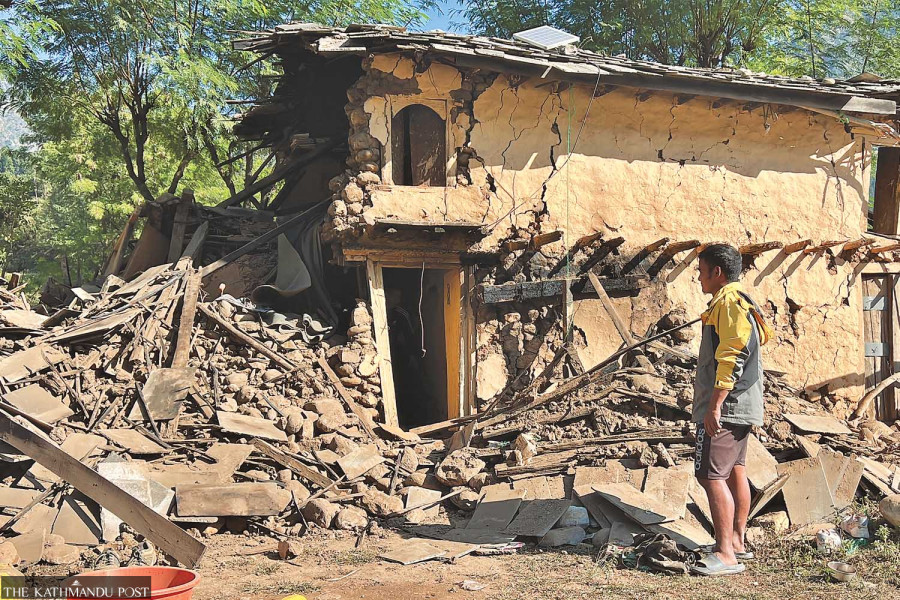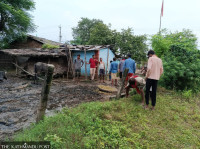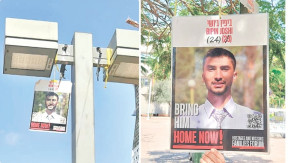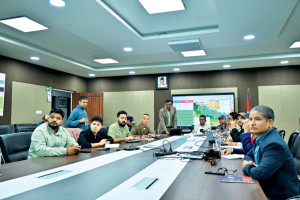National
Friday’s quake damaged around 8,000 houses in Jajarkot and Rukum West
As per the home ministry’s initial estimates, around 3,000 houses were fully and 5,000 were partially damaged.
Prithvi Man Shrestha
The deadly earthquake on Friday night damaged around 8,000 houses—both public and private—besides killing at least 157 people in Jajarkot and Rukum West districts in western Nepal, officials said.
The quake caused the worst human and infrastructure losses since the devastating jolt of April 2015.
“As per the initial estimate, around 3,000 houses have been fully damaged while an additional 5,000 suffered partial damages,” said Narayan Prasad Bhattarai, spokesman for the home ministry. “The final tally of damaged homes is yet to come.”
According to him, the houses fully damaged should be rebuilt while those partially damaged will need repair and maintenance.
In 2015, a 7.8 magnitude quake had damaged nearly 800,000 houses besides killing nearly 9,000 people, according to the Post Disaster Needs Assessment Report, 2015. Likewise, 920 heritage sites, 402 monasteries, 7,553 schools, 1,197 health institutions, 415 government buildings, 216 buildings of security agencies and 672 km of road in various districts were damaged.
According to a report in Kantipur, sister publication of the Post, Friday’s earthquake left as many as 2,136 houses in Rukum West fully damaged and 2,642 houses partially damaged.
As many as 4,670 houses suffered minor damages, according to the report referring to the District Administration Office (DAO), Rukum West. As per the initial estimates, the total damage caused by the earthquake in the district has been estimated at more than Rs2 billion.
Likewise, according to the Kantipur report, as many as 905 houses in Jajarkot were damaged fully and 2,745 partially.
Ramidanda village in ward 1 of Barekot Rural Municipality was the epicentre of the latest earthquake. According to the rural municipality, there are around 3,500 houses there.
“There is hardly any house intact after the earthquake. At least 90 percent of them need to be rebuilt,” Bir Bahadur Giri, chairman of the rural municipality, told the Post on Saturday.
Besides causing damage to buildings, roads and bridges were also damaged, according to the Department of Roads.
The quake caused three large landslides along the Pasagad-Rimna section in the Bheri Corridor (Jajarkot-Dunai) damaging the road section and disrupting vehicular movement. Likewise, the quake also triggered a large landslide at Khalanga-Panchkatiya section. A bridge in the Rimna area of Jajarkot also suffered minor damage, the department said.
“Nepal’s road and bridge infrastructure largely withstood the 2015 earthquake,” said Sushil Dhakal, director general at the Department of Road. “There was no big damage to these infrastructures in the latest earthquake too.”
The government is yet to estimate the damages in monetary terms. But the Cabinet meeting on Sunday decided to carry out reconstruction of the damaged infrastructure by formulating an integrated action plan.
As per the Cabinet decision, the Ministry of Urban Development will take forward the reconstruction work by ensuring that new structures are quake-resistant, and the task will be completed within a year. “The road and communication infrastructure affected by the quake will be repaired and brought into operation immediately,” states the Cabinet decision.




 19.12°C Kathmandu
19.12°C Kathmandu















